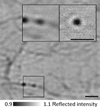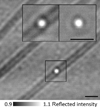Interferometric Scattering Microscopy for the Study of Molecular Motors
- PMID: 27793291
- PMCID: PMC5098560
- DOI: 10.1016/bs.mie.2016.08.016
Interferometric Scattering Microscopy for the Study of Molecular Motors
Abstract
Our understanding of molecular motor function has been greatly improved by the development of imaging modalities, which enable real-time observation of their motion at the single-molecule level. Here, we describe the use of a new method, interferometric scattering microscopy, for the investigation of motor protein dynamics by attaching and tracking the motion of metallic nanoparticle labels as small as 20nm diameter. Using myosin-5, kinesin-1, and dynein as examples, we describe the basic assays, labeling strategies, and principles of data analysis. Our approach is relevant not only for motor protein dynamics but also provides a general tool for single-particle tracking with high spatiotemporal precision, which overcomes the limitations of single-molecule fluorescence methods.
Keywords: Dynein; High speed; Interferometric scattering microscopy; Kinesin; Molecular motors; Myosin; Single molecule; Single-particle tracking.
© 2016 Elsevier Inc. All rights reserved.
Figures






References
-
- Allen RD, Metuzals J, Tasaki I, Brady ST, Gilbert SP. Fast axonal-transport in squid giant-axon. Science. 1982;218(4577):1127–1129. - PubMed
-
- Arroyo JO, Cole D, Kukura P. Interferometric scattering microscopy and its combination with single-molecule fluorescence imaging. Nature Protocols. 2016;11(4):617–633. - PubMed
MeSH terms
Substances
Grants and funding
LinkOut - more resources
Full Text Sources
Other Literature Sources
Miscellaneous

